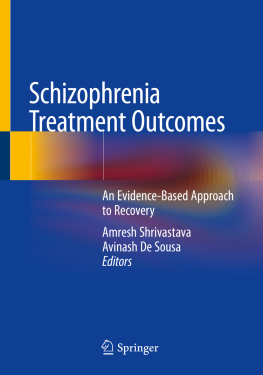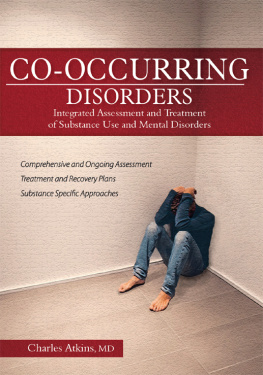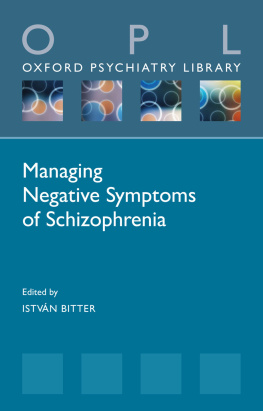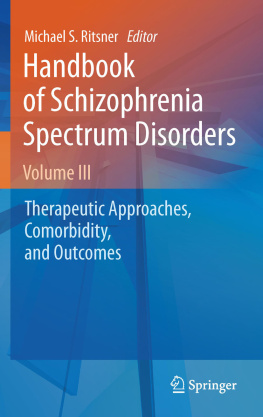Amresh Shrivastava - Schizophrenia Treatment Outcomes: An Evidence-Based Approach to Recovery
Here you can read online Amresh Shrivastava - Schizophrenia Treatment Outcomes: An Evidence-Based Approach to Recovery full text of the book (entire story) in english for free. Download pdf and epub, get meaning, cover and reviews about this ebook. year: 2020, publisher: Springer Nature, genre: Home and family. Description of the work, (preface) as well as reviews are available. Best literature library LitArk.com created for fans of good reading and offers a wide selection of genres:
Romance novel
Science fiction
Adventure
Detective
Science
History
Home and family
Prose
Art
Politics
Computer
Non-fiction
Religion
Business
Children
Humor
Choose a favorite category and find really read worthwhile books. Enjoy immersion in the world of imagination, feel the emotions of the characters or learn something new for yourself, make an fascinating discovery.
- Book:Schizophrenia Treatment Outcomes: An Evidence-Based Approach to Recovery
- Author:
- Publisher:Springer Nature
- Genre:
- Year:2020
- Rating:4 / 5
- Favourites:Add to favourites
- Your mark:
- 80
- 1
- 2
- 3
- 4
- 5
Schizophrenia Treatment Outcomes: An Evidence-Based Approach to Recovery: summary, description and annotation
We offer to read an annotation, description, summary or preface (depends on what the author of the book "Schizophrenia Treatment Outcomes: An Evidence-Based Approach to Recovery" wrote himself). If you haven't found the necessary information about the book — write in the comments, we will try to find it.
Schizophrenia Treatment Outcomes: An Evidence-Based Approach to Recovery — read online for free the complete book (whole text) full work
Below is the text of the book, divided by pages. System saving the place of the last page read, allows you to conveniently read the book "Schizophrenia Treatment Outcomes: An Evidence-Based Approach to Recovery" online for free, without having to search again every time where you left off. Put a bookmark, and you can go to the page where you finished reading at any time.
Font size:
Interval:
Bookmark:
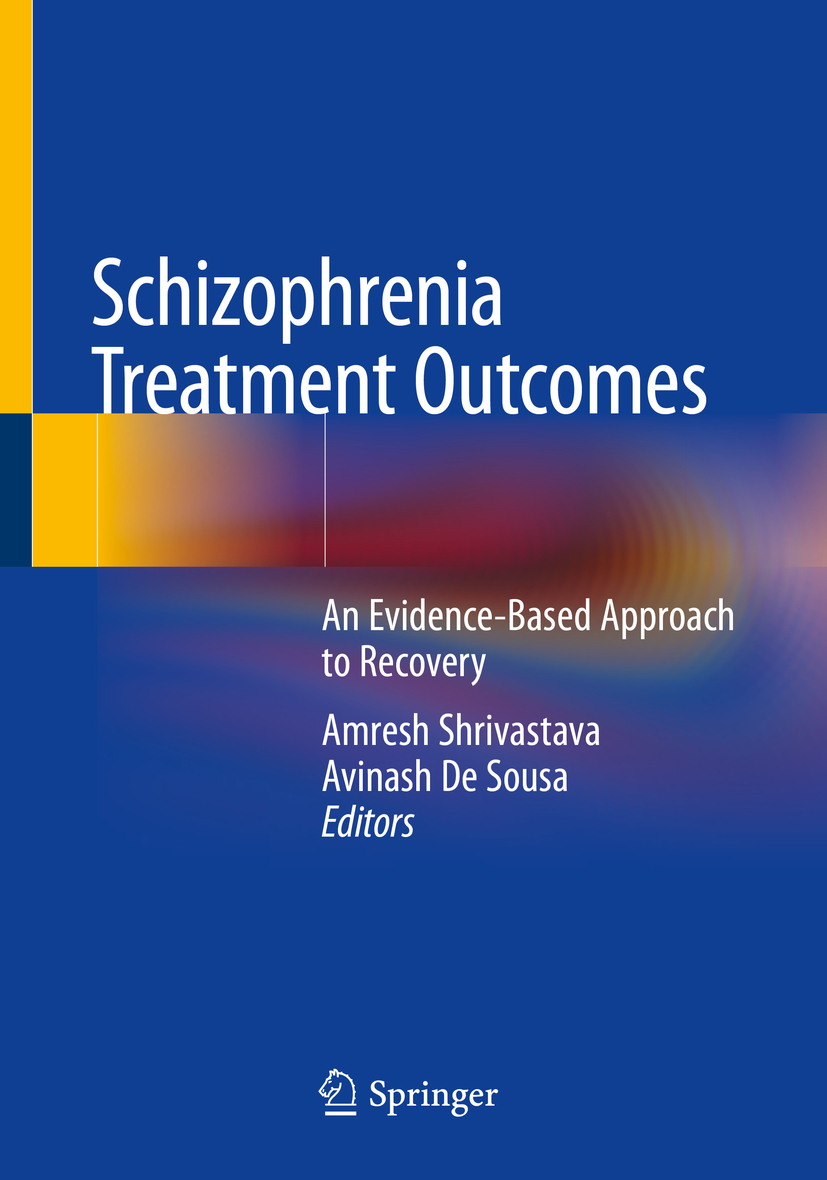

This Springer imprint is published by the registered company Springer Nature Switzerland AG
The registered company address is: Gewerbestrasse 11, 6330 Cham, Switzerland
This book addresses many aspects of clinical care relevant for persons with a diagnosis of schizophrenia. Organized around the evidence gathered within schizophrenia, the various chapters will prove relevant for many psychotic disorders. It is impossible to be comprehensive since there are so many variables involved and so much variation between patients. But this is the most comprehensive effort to date, with presentations in a brief and understandable framework. This foreword provides a view on concepts related to understanding schizophrenia and the integration of therapeutics at the individual level.
The Biopsychosocial Medical model provides the framework for integrating patient-centered information. This model calls attention to levels in human function where therapy can be initiated. More fundamentally, the model is a general systems concept calling for integration across each level. For example, if blushing were a disease, a vascular physiologist could explain the physiology of reddening of the face, but the causative role of shame is understood at the psychological level, and why the blush occurs in public requires explanation at the social level. So it is with schizophrenia, where a cognitive intervention at the psychological level seeks understanding of effects on brain physiology and simultaneously observes effects on social cognition and function.
Conceptualizing schizophrenia is important, and for too long the field has held the view that schizophrenia is a disease or, to be more specific, a brain disease. A brief history will clarify. Kraepelin initiated this view with dementia praecox and put in place the expectation of a chronic and deteriorating course. He held that dissociative pathology and weakening of the wellsprings of volition were the core pathologies that, together with a poor prognosis, defined a disease entity. Bleuler proposed that the dissociative pathology was the core pathology in all cases of schizophrenia, hence meeting the concept of a specific disease entity based on shared pathophysiology. Bleuler, by the way, viewed hallucinations and delusions as secondary pathologies and not core manifestations of schizophrenia. This, with the defining of manic-depressive psychosis, places conceptual approaches to schizophrenia in the disease entity category. In the 1960s and 1970s the observations of substantial heterogeneity in development, manifestation, and course challenged the single disease concept. This heterogeneity may be the result of a broad, overinclusive diagnostic practice. An alternative view held that nuclear or true schizophrenia based on specific criteria provided a disease entity consistent with the concept following Kraepelin and Bleuler. But note that the key diagnostic criteria advocated were symptoms of first rank described by Schneider as meaning the presence of schizophrenia in the absence of delirium. These special forms of hallucinations and delusions quietly shifted the concept from dissociative pathology and avolition to reality distortion. This view was sufficiently influential for DSM-III in 1981 to highlight these first-rank symptoms as sufficient to meet the A criteria. Negative symptoms were omitted altogether.
The International Pilot Study of Schizophrenia was initiated in 1968 to determine if schizophrenia was similar in different locations. Similar cases were found in all nine countries, but a broader concept was used in some centers, including the NIMH center where John Strauss, John Bartko, and I were working. We found the Schneiderian first-rank symptoms in bipolar and other psychotic conditions in our center and confirmed in other centers. Dividing our broad schizophrenia sample into nuclear or true schizophrenia versus pseudo schizophrenia, we falsified the developmental and course predictions based on first-rank symptoms. Our conclusion was that schizophrenia is a clinical syndrome rather than a specific disease entity and that the study of schizophrenia required deconstruction and the component parts were the targets for discovery and for clinical application. These conclusions were published in 1974 [Strauss JS, Carpenter WT Jr, Bartko JJ. The diagnosis and understanding of schizophrenia. Part III. Speculations on the processes that underlie schizophrenic symptoms and signs. Schizophr Bull. 1974 Winter; (11):619] but failed to influence DSM-III, and it was not until DSM-5 that first-rank symptoms lost their special status and schizophrenia as a clinical syndrome was made explicit. While schizophrenia as a disease is still in common use, the twenty-first century has brought a major shift to the clinical syndrome view, with science moving rapidly to deconstruction, and clinical application aimed at specific aspects of psychopathology and function, with diagnosis only as a starting point. There is wide recognition that symptoms cross diagnostic boundaries. It is within this clinical syndrome concept that the present book addresses schizophrenia.
The 29 chapters in this book inform the reader on many of the conceptual issues and therapeutic opportunities in the clinicians tool box. Individuals with a schizophrenia diagnosis will vary in which domains of pathology are present and what functional areas need to be addressed. Chapters range from pharmacotherapy to pathways and approaches for recovery; from directly addressing impairments to approaches based on compensatory and resilience mechanisms; from medical attention to metabolic and comorbid pathology to peer support and holistic approaches; from individual issues such as suicide and cannabis use to population issues such as challenges in low-income countries and therapeutics at different life stages. And much more.
Font size:
Interval:
Bookmark:
Similar books «Schizophrenia Treatment Outcomes: An Evidence-Based Approach to Recovery»
Look at similar books to Schizophrenia Treatment Outcomes: An Evidence-Based Approach to Recovery. We have selected literature similar in name and meaning in the hope of providing readers with more options to find new, interesting, not yet read works.
Discussion, reviews of the book Schizophrenia Treatment Outcomes: An Evidence-Based Approach to Recovery and just readers' own opinions. Leave your comments, write what you think about the work, its meaning or the main characters. Specify what exactly you liked and what you didn't like, and why you think so.

